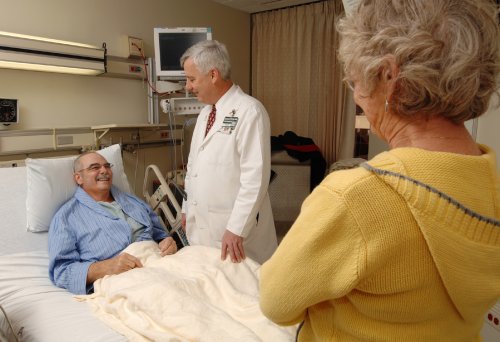
Bill Putnam, M.D., center, talks with patient Donald Mobley and his wife, Maris, after Mobley’s recent surgery. (photo by Anne Rayner)
Cardiothoracic surgical team tackles patient’s rare sarcoma
Donald Mobley spends most days on the golf course in his hometown of Evansville, Ind. But last July, the 68-year-old Alcoa retiree realized something was wrong.
“I just noticed my wind was getting shorter and I was not as strong,” said Mobley.
His family doctor ordered several scans which revealed a mass in his chest. The tumor was a pulmonary artery sarcoma, a type of cancer that resides in soft tissue. Mobley's tumor was in a precarious place — wrapped around his pulmonary artery.
Chemotherapy helped shrink it, but Mobley's best hope for a cure was surgical removal. He traveled to Vanderbilt for a second opinion from Joe B. (Bill) Putnam, M.D., chair of the Department of Thoracic Surgery. In his 20 years of surgery, Putnam, Ingram Professor of Cancer Research at Vanderbilt-Ingram Cancer Center, had seen only a handful of sarcomas in such a precarious spot.
“Mr. Mobley had no good options,” Putnam said. “The tumor wasn't that big, perhaps two inches, but it was in a bad location, beneath the aortic arch and involving the main pulmonary artery. It also extended into the left lung, so the left lung could not be saved.”
Putnam was willing to tackle the delicate surgery, but there were many unknowns.
“Like the tip of the iceberg, you don't know what's underneath. We knew what we could see from our X-rays, but I was concerned there could be additional disease present that might involve the aorta, the heart valves or the heart muscle.”
Putnam also knew they would need to use a heart-lung machine to support Mobley's breathing and blood supply during the operation, increasing the procedure's complexity.
Putnam pulled together the surgical team, including James Greelish, M.D., assistant professor of Cardiac Surgery, Robert Deegan, M.D., Ph.D., director of the Division of Cardiothoracic Anesthesia, and a group of experienced surgical nurses.
“You have the experts in thoracic oncology techniques to get the cancer out, as well as the vascular and cardiac techniques to support the heart and lungs as well as repair the blood vessels,” Putnam said. “The ability to integrate this type of care is really one of the distinctive competencies of Vanderbilt. Not a lot of places can do this.”
That team concept was reassuring to Mobley.
“Before Dr. Putnam, the doctors were giving me a 50-50 chance. Dr. Putnam took a personal interest right away and he gave us hope.”
During the lengthy procedure, the surgical team removed part of Mobley's pulmonary artery, patching it with tissue from the pericardium, which surrounds the heart. The tumor had also invaded a nerve to the vocal cords and a nerve to the diaphragm. Those nerves had to be removed, leaving him with a soft, whispery voice.
But Mobley used to sing bass in the Evansville Philharmonic and his church choir. So a Vanderbilt otolaryngologist joined the care team, performing a procedure to fatten up the vocal cord in a second operation that should improve Mobley's ability to speak.
“This is an excellent example of multispecialty care in the operating room and multidisciplinary care in the perioperative period,” said Putnam. “To have this available at Vanderbilt is a terrific complement to any academic medical center.”
Mobley may face additional chemotherapy, but his prognosis looks good. He's glad he came to Vanderbilt for that second opinion, especially if the operations enable him to resume his golf game. He urges others to start an exercise program, because it was shortness of breath on the golf course that gave him an early warning that something was wrong.
“I'm a Vanderbilt advocate and I would be a good salesman for this medical center.”













